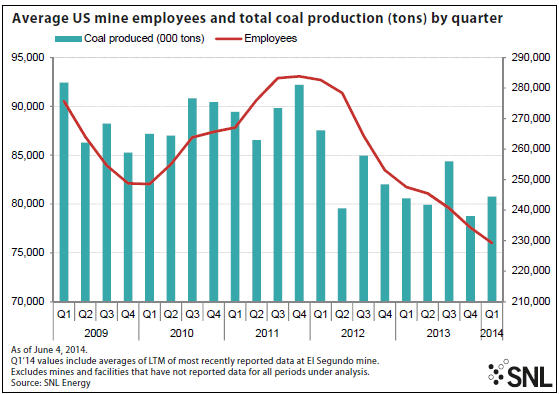A free fall in U.S. coal mining employment that began after a near-term peak in the final quarter of 2011 has extended into 2014, with first-quarter employment dropping by more than 5,700 jobs, or a decline of about 7.0%, compared to same quarter a year ago.
An SNL Energy analysis of average coal employment data from the U.S. Mine Safety and Health Administration shows the average number of employees in the one-year period ended March 31 fell about 8.3% year over year to 79,658 employees. For the first quarter, the analysis found the average employee count at U.S. coal mines was 76,012, the lowest level since at least first quarter 2009. The analysis shows about 1,574 fewer average coal jobs between fourth quarter 2013 and first quarter 2014.
year over year to 79,658 employees. For the first quarter, the analysis found the average employee count at U.S. coal mines was 76,012, the lowest level since at least first quarter 2009. The analysis shows about 1,574 fewer average coal jobs between fourth quarter 2013 and first quarter 2014.
Starting in the first quarter of 2009, coal mine employment dropped for about a year before rebounding over about two years to a near-term peak by the end of 2011. However, since coal mining employment hit the recent high of 93,084 jobs in the fourth quarter of 2011, the industry has consistently posted quarterly declines in total employment, while fluctuating levels of production have generally trended downward.
SNL Energy’s analysis excluded 33 mines that had not yet reported data for all the periods analyzed.
Coal’s employment woes stand in contrast to the U.S. as a whole. According to the U.S. Department of Labor’s recent jobs report released June 6, total nonfarm employment rose by 217,000 jobs in May. The Washington Post reported that May’s job gains mean the country has essentially recaptured all the jobs lost during the recession and that employment is now at an all-time high of 138.4 million people, though population growth means the share of people who have a job remains smaller than before the recession began in 2007.
Coal’s outlook likely worse under new rules
The employment outlook in the coalfields could get worse if new regulations proposed by the U.S. EPA come to fruition. While the EPA’s newly proposed Clean Power Plan offers public health and climate benefits worth an estimated $55 billion per year to $93 billion per year in 2030, and a net increase in U.S. jobs, it also projects significant declines in coal sector employment.
New greenhouse gas limits on existing coal-fired power plants announced by the EPA on June 2 project that coal production for use in the domestic electric power sector will decline roughly 25% to 27% in 2020 from base case levels. In 2030, the EPA projects, the use of coal by the power sector will decrease roughly 30% to 32%.
Comments
web proxy free
Another reason why you should definitely use the free anonymous web surfing proxy is if you
want to visit certain sites that you have no access to. This mainly happens in schools,
universities, some corporations, where servers are used to block the users from surfing
some sites. However, with the help of free anonymous web surfing proxy, this as well can
not be a problem anymore, because the user can bypass the filters and then he/ she has
access to any information he/ she desires.